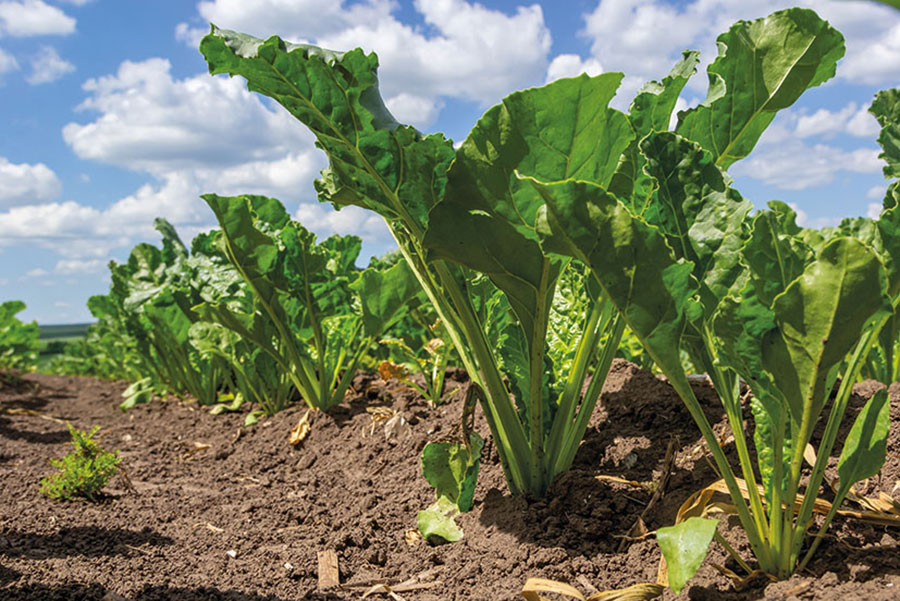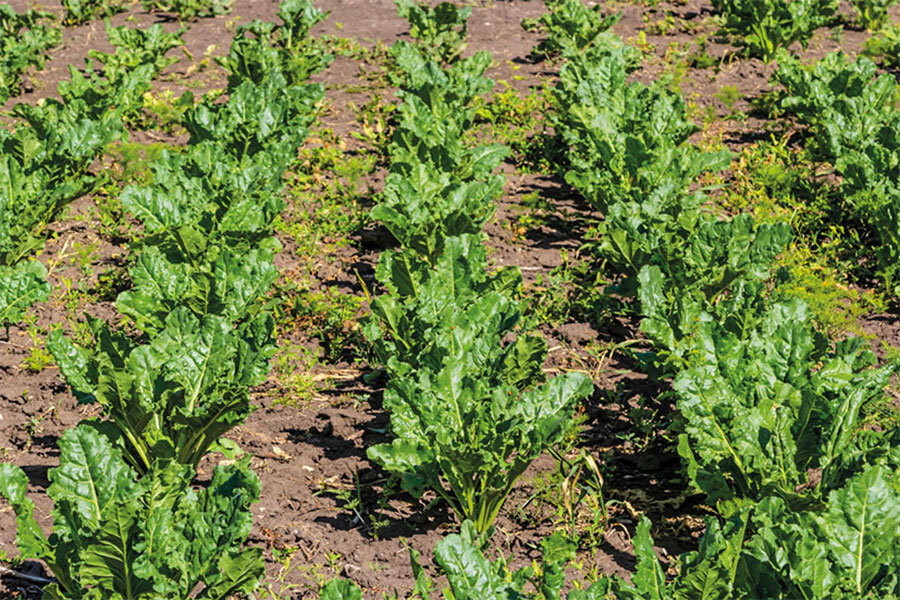Sugar beet experts give their advice for this spring
29th March 2024
Experts from Ceres Rural, British Sugar and De Sangosse discussed the prospects for sugar beet this season and recommendations for herbicide programmes in a webinar hosted by UPL.

Examining budgets and potential margins from sugar beet this season is Jock Wilmott, a partner and agronomist at Ceres Rural. He works with farmers in the Cambridgeshire – Hertfordshire area and has been advising on sugar beet crops for over 20 years.
“We do gross margin calculations for sugar beet,” says Mr Wilmott. “When you put the new (contract) price in, it looks competitive against combinable crops, certainly combinable break crops.
“Historically, we haven’t tended to look at sugar beet on a cost-per-tonne basis as we have done with cereals. At £40/t, you would think the margins would be healthy, but if you look at it on a per-tonne basis, it isn’t as good as first thought.”
Not including the 2023/24 crop, the five-year average beet yields for the country are 71.5t/ha at 17% sugar, explains Mr Wilmott. Using his average growing figures, an average crop costs almost £30/t to grow. Adding a land rent of £500/ha increases the growing costs for an average yield to £37/ha. Mr Wilmott advises that the best way to improve sugar beet margins is to push the yield.
“Looking at the prices for cereals, the issues getting wheat crops established and how well they look, beet has to pull its weight this year. It is all the more important to get the yield above 80t/ha if you can,” he says.
Analysing the growing costs overall, crop inputs (40–45%) comprise the most significant part. Harvest and transport (40–45%) also represent a large percentage, although British Sugar’s transport allowance or beet delivery service will help to offset some of this. Seedbed preparation, drilling, spraying, fertiliser spreading and agronomy are the smallest contributions to growing the crop but are the most important, states Mr Wilmott.
“We don’t know what (weather) we will face this spring, and the costs are more finely balanced than the £40/t headline price would suggest.
“It is all about establishing the crop well, getting it growing, and closing the canopy. This will help protect against virus yellows and mitigate any late herbicide sprays.
“Patience and attention to detail when preparing land for sugar beet will be critical this year. There is a margin in sugar beet, which has to support the other crops in the rotation, so a lot relies on a decent year.”
Spray intervals are crucial to good weed control
Drilling down into herbicide programme costs this spring, Jock predicts most crops will need four post-emergence broad-leaved weed sprays costing at least £150/ha. In most of the scenarios Jock comes across, he has to do something to control black-grass, which adds roughly another £35/ha for Centurion Max (clethodim).
Controlling volunteer potatoes with clopyralid or adding a pre-emergence spray further increases the overall cost.
“Where there are issues with weed control, often it is because the spray intervals are too wide,” says British Sugar technical support manager, Pam Chambers. “My view is to follow up a successful first post-emergence spray closely with a second, especially if there is a high weed burden.”
“Intervals between sprays become more of an issue when it is dry,” adds Mr Wilmott. “The beet can be growing slowly, and weed emergence is protracted. In this situation, there won’t be much help from the residual herbicide, so you will rely on contact activity.
“This is when intervals can become drawn out. Once there is rain, everything goes again, and the timings tighten.
“Since we lost Betanal Maxxpro (ethofumesate + phenmedipham + desmedipham + lenacil), we don’t have the products to get us out of jail. We can manage with the actives we have, but we must be more adaptable.”
Ms Chambers agrees that the industry has missed desmedipham to boost the activity of herbicides, but she believes its role can be partially replaced with adjuvants.
“In some situations, not including an adjuvant (with a herbicide) is like having gin without the tonic. In trials, I have seen a 50% increase in efficacy by including an adjuvant.”
Adjuvant advice for herbicide programmes
The primary reason for using an adjuvant oil with herbicides is to break down the waxes on a weed leaf surface to allow faster penetration of the herbicide into the weed, describes Rob Sucking, commercial technical manager at De Sangosse.
“Ultimately, adjuvants increase herbicide uptake. In conditions like moderate to serve frosts, high diurnal range and fast-growing crops, using an adjuvant can increase the potential for herbicidal crop phyto expected under these conditions.”

Newman Cropspray 11-E is one of the most common adjuvant oils used with beet herbicides. Mr Sucking reminds growers of the advice for the rate depending on the temperature.
Up to 18ºC, and he recommends a dose rate of 0.75-litres/ha. The rate should be dropped to 0.5-litres/ha if the temperature is between 18ºC and 21ºC, and growers should switch to a methylated seed oil (MSO) above 21ºC.
Mr Sucking explains the reason for the switch to an MSO like Phase II at higher temperatures is because the droplet spreads on drying, dissipating the herbicide across the leaf surface, whereas mineral oil contracts the droplet when it dries, increasing the herbicide concentration.
Straight versus co-form herbicides
When talking about straight herbicides, Ms Chambers says they are based on metamitron, ethofumesate, and phenmedipham.
The three actives combined have a synergistic effect. Ms Chambers describes a 2022 BRRO and UPL trial at Bracebridge Health, which had a high population of fat hen of 44 plants per m2. Three sprays of an ethofumesate, phenmedipham and metamitron tank mix gave 100% control. This is compared to ethofumesate and phenmedipham, which only give 38% control by themselves and 84% control together without metamitron.
“In certain situations, a co-formulated (herbicide) solution fits,” says Mr Wilmott. “A dynamic situation where you have a mixture of dry and wet periods in the spring and sprayers are busy suits straight herbicides because you can adjust the rates up and down.
“Some activities, like quinmerac, are only available in co-forms, but for the most part, we can do what we need to do with straight products.”
To do a pre-emergence herbicide or not?
Whether there is a value in a pre-emergence herbicide for sugar beet often divides opinion among agronomists and growers. Ms Chambers highlights how the soil moisture in 2023 resulted in good weed control from a pre-em.
“If you have black-grass, I would look to do a pre-em of ethofumesate plus metamitron,” she says. “Another good reason for a pre-em is if you are pushed for time and think the first post-em sprays will be challenging to apply at the correct time.”
Ms Chambers would recommend using straight ethofumesate and metamitron when doing a pre-em.
“Unless you have problem weeds, I don’t think you need to play that (pre-em) card,” adds Mr Wilmott. “Although, if you are growing a lot of beet, it certainly helps to take the pressure off. Doing some early metamitron followed by some rain will deliver a return. However, I don’t advise you to do it until you have seen the conditions ahead.”
Weed control advice for herbicide-tolerant beet
The area sown with herbicide-tolerant Conviso sugar beet varieties in 2023 was around 20,000ha. British Sugar predicts a similar area this season.
The yield gap between Conviso varieties and conventional ones is closing. The one area where growers should avoid Conviso is if they have a beet cyst nematode (BCN) problem, cautions Ms Chambers. There are no BCN-tolerant Conviso varieties, although some are in development.
Mr Wilmott expects most Conviso sugar beet to receive a conventional pre-emergence herbicide to help with the control of weeds like black bindweed and give greater flexibility for the Conviso One (foramsulfuron + thiencarbazone-methyl) timing.
“One conventional broad-leaved weed spray and the Conviso herbicide is not expensive,” he says. “However, you also have to consider the additional cost of the seed and following the stewardship of the technology (by controlling bolters).
“There is also the question of what to do with black-grass. Conviso One is a relatively good black-grass herbicide, but it is similar sulfonylurea (SU) chemistry to that being used elsewhere in the rotation, like Atlantis (metsulfuron-methyl + iodosulfuron-methyl).”
Growers should be mindful of the resistance status of the black-grass populations in their fields and use a black-grass active pre-emergence spray and Centurion Max in a programme with Conviso One if they think they have target site resistance, encourages Mr Wilmott.
British Sugar has undertaken a mini project with ADAS to screen weed populations for broad-leaved weed ALS resistance in a few fields. Seeds taken from poppies and chickweed that survived the herbicide programme were examined for herbicide sensitivity, and they did find some levels, although Ms Chambers stresses that some incidents of poor control were not related to resistance.
“It is not surprising,” explains Ms Chambers. “Over 160 species (globally) are resistant to ALS chemistry.
“In the past, we wouldn’t notice herbicide resistance in sugar beet because we are very good at tank mixing different herbicides.
“When you come to Conviso One, it is just one type of chemistry; tank mixing is not allowed. We need to look at including conventional herbicides (in Conviso programmes) at pre- and early post-emergence, especially if there is any suspicion of ALS resistance.”
Read more arable news
